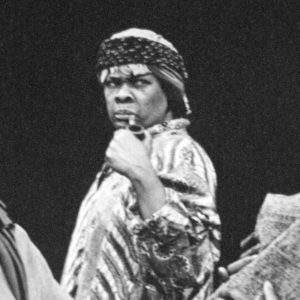From a Profile in the NY Times on August 8, 1999
IN the 1930’s, long before televisions appeared in the modest living rooms of West Philadelphia, Parthenia Milner and her two older sisters furnished their own evening’s entertainment by reading aloud from a well-worn and much loved volume of poetry given to them by their mother. Turning the frayed pages, the daughters of Mattie Byrd Milner, a schoolteacher from Athens, Ga., recited the verses in impassioned voices, transforming quiet nights in their mostly black urban neighborhood into gala family affairs.
For the youngest child, the recitations were just a first step in what would become a lifetime devoted to the performing arts. By the time she was 6, Parthenia had also learned to play the piano by ear, often regaling audiences at parties held by the dairy business that employed her father, Frank Milner, as a delivery man.
”Looking back, you could say I was born performing,” said the actress, 71, who has been known for the last five decades by her stage name, Tina Sattin. She spoke in an interview at the Open Cage Theater here, which she founded 24 years ago, as a nonprofit regional performance center and school for aspiring actors.
Between the strict Baptist upbringing her mother favored and what she described as ”the holy roller storefront church” her father attended, music and religious pageants became a way of life — as later the theater did. As a young woman studying to be a lawyer she put aside her education to join a touring company alongside her husband, the singer Lonnie Sattin, with whom she had a son and a daughter.
In the ensuing years, Ms. Sattin landed roles in Broadway shows, Off Broadway productions, television dramas (including ”Kojak,” ”The Secret Storm” and ”Guiding Light”) and television commercials.
She was also in touring companies for ”As You Like It” and ”The Skin of Our Teeth,” among others. And she has been honored by organizations like the Black Women’s Political Caucus and the Council for the Arts in Westchester for her contributions to theater.
The actress — whose kinetic body and face are in constant motion — described herself as a performer ”with dark skin and a Negroid face” who lacks the classical chiseled features of a star like Lena Horne, who with her lighter skin was more likely to get ahead. She explained that lighter-skinned blacks were more likely to get ahead in the 40’s and 50’s. She attributes much of what she has accomplished to her mother, ”an overcoming woman who sought out the best for her children and taught them to do that for themselves as well,” she said.
During the years she was a working actress, Ms. Sattin garnered significant praise for mastering her craft: ”A voice like hot-buttered rum,” was the way that one reviewer, Vianne Webb of The Times-Herald in Newport News, Va., described her; another critic, Nancy Funk of The Salt Lake Tribune, said she was ”an actress who stood out.”
But along with the glamorous life style also came the less than positive reviews, a failed marriage and a continuing financial and emotional struggle to obey the show business dictum ”the show must go on,” whatever the cost.
”Sometimes I think I’m constantly being tested,” she said recently. ”Just when things are going smoothly, something gets thrown in my way.”
The obstacle was once presented by well-meaning friends and family members who believed the high-achieving young student was ”too dark-skinned” to attend a high school for college-bound students. She did not heed their advice and went on to attain a scholarship to Howard University.
| Credit Type | Production | Season |
|---|---|---|
| Actor | Widows | 1980-81 Season |


